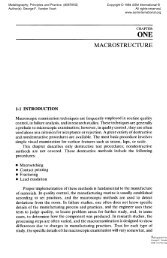Sample Chapter - asm iron and steel - ASM International
Sample Chapter - asm iron and steel - ASM International
Sample Chapter - asm iron and steel - ASM International
You also want an ePaper? Increase the reach of your titles
YUMPU automatically turns print PDFs into web optimized ePapers that Google loves.
© 2002 <strong>ASM</strong> <strong>International</strong>. All Rights Reserved.<br />
Metallographer’s Guide: Irons <strong>and</strong> Steels (#06040G)<br />
6 / Metallographer’s Guide<br />
ASTMdesignation Type of <strong>steel</strong><br />
A 1 Carbon <strong>steel</strong>, tee rails<br />
A 36 Structural <strong>steel</strong><br />
A 131 Structural <strong>steel</strong> for ships<br />
A 228 Steel wire, music spring quality<br />
A 307 Carbon <strong>steel</strong>, bolts <strong>and</strong> studs, 420 MPa (60 ksi) tensile<br />
strength<br />
A 510 Carbon <strong>steel</strong> wire rods<br />
A 529 Structural <strong>steel</strong> with 290 MPa (42 ksi) minimum yield point<br />
A 570 Steel, sheet <strong>and</strong> strip, carbon, hot rolled, structural quality<br />
A 709 Structural <strong>steel</strong> for bridges<br />
As examples, two of these ASTM specifications are described in<br />
more detail: ASTM A 1 for railway rails <strong>and</strong> ASTM A 36 for<br />
structural <strong>steel</strong>s (structural beams, plate, etc.).<br />
ASTM A 1 requires that railroad rails have certain composition<br />
limits <strong>and</strong> a minimum hardness. For example, for a common rail<br />
size of 60 kg/m (132 lb/yd) the requirements are:<br />
Carbon 0.72–0.82%<br />
Manganese 0.80–1.10%<br />
Phosphorus 0.035% max<br />
Sulfur 0.040% max<br />
Silicon 0.10–0.20%<br />
Hardness 269 HB min<br />
The microstructure of a typical ASTM A 1 rail <strong>steel</strong> is shown in<br />
Fig. 1.4. The microstructure is 100% pearlite.<br />
ASTM A 36 for structural <strong>steel</strong>s is very different from ASTM A<br />
1 for rail <strong>steel</strong> in that it specifies only a minimum carbon content<br />
<strong>and</strong> certain tensile properties. ASTM A 36 has the following<br />
requirements:<br />
Fig. 1.4<br />
Micrograph of ASTM A 1 rail <strong>steel</strong> showing the fully pearlitic<br />
microstructure. Etched in 4% picral. 500<br />
Carbon 0.26% max<br />
Yield point 248 MPa (36 ksi) min<br />
Tensile strength 400–552 MPa (58–80 ksi)<br />
Total elongation (in 50 mm, or 2 in.) 21% min<br />
The microstructure of a typical ASTM A 36 structural <strong>steel</strong> is<br />
shown in Fig. 1.5. The microstructure is a mixture of pearlite <strong>and</strong><br />
ferrite, with some manganese sulfide stringers.<br />
The ASTM specifications illustrated previously are rather<br />
simple. As the product becomes more critical <strong>and</strong> the composition<br />
more complex, the requirements exp<strong>and</strong> considerably.<br />
Alloy Steels<br />
The alloy <strong>steel</strong>s are generally divided into two classes: the<br />
low-alloy <strong>steel</strong>s <strong>and</strong> the high-alloy <strong>steel</strong>s. They are divided<br />
according to composition as follows:<br />
Type Alloying elements, %<br />
Low-alloy <strong>steel</strong>s 8<br />
www.<strong>asm</strong>international.org<br />
The AISI/SAE Classification System for Low-Alloy Steels.<br />
As with the plain carbon <strong>steel</strong>s, there is an established classification<br />
system of AISI/SAE designations for the low-alloy <strong>steel</strong>s.<br />
The classification is based on the principal alloying element(s) in<br />
the <strong>steel</strong>. These principal elements include carbon, manganese,<br />
silicon, nickel, chromium, molybdenum, <strong>and</strong> vanadium. Each<br />
element, either singly or in combination with other elements,<br />
imparts certain properties <strong>and</strong> characteristics to the <strong>steel</strong>. The role<br />
of each element was described in Table 1.1. The subsequent list<br />
gives the breakdown of the AISI/SAE classification for the<br />
low-alloy <strong>steel</strong>s:<br />
Fig. 1.5 Micrograph of ASTM A 36 structural <strong>steel</strong> showing a microstructure<br />
consisting of ferrite (light etching constituent)<strong>and</strong> pearlite<br />
(dark etching constituent). Etched in 4% picral followed by 2% nital. 200
















